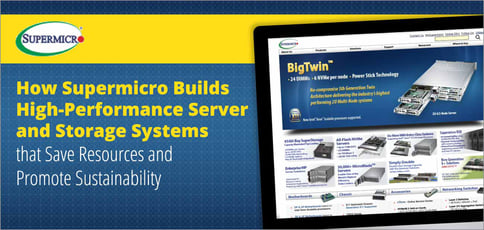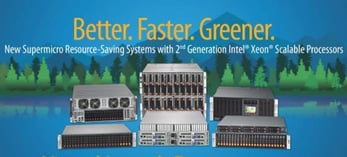
TL; DR: For more than 25 years, Supermicro has built innovative server and storage systems in Silicon Valley for even the most demanding workloads. The company’s building-block approach allows it to customize — and optimize — systems for any customer, no matter the application or market. The company also designs technology to help its customers shift to more environmentally friendly and cost-effective setups. And Supermicro’s in-house team remains committed to building the most advanced servers on the market and providing leading-edge solutions.
By the time Silicon Valley got its nickname in the early 1970s, it was already at the epicenter of technological innovation in the United States. And the legend of the Northern California region, famous for its concentration of silicon computer chip companies, has only grown.
Charles Liang, Founder of Silicon Valley’s Supermicro, has been a part of that explosive growth since he started the company in 1993. Supermicro builds server and storage systems for some of the world’s key web service providers and designs, engineers, and manufactures the vast majority of its products in its 2 million-square-foot facility in San Jose, California.
The company also optimizes systems for the specific workloads of large OEM customers. Many of those companies once built their server products in-house, but today, they often purchase products from Supermicro and package them with their own software.
Because the company grew up in such a competitive market, it has always focused on innovation and providing a wide range of tailored products.
“We don’t run a traditional enterprise with a one-size-fits-all model,” said Michael McNerney, Supermicro Vice President of Marketing and Network Security. “We build hardware tuned for web service providers’ specific applications so that when they scale out at massive levels, it remains optimized for that application.”
Today, Supermicro builds millions of pieces of hardware each year and is one of the top five server vendors in the world. The business is scaling rapidly, growing revenue, and focusing on its strengths — which include autonomy.
“It’s fun to see this growth curve. Recently, we built a fairly large datacenter in Santa Clara. We went from designing on paper to full systems architecture in six weeks,” said Michael. “We couldn’t do that if we had to talk to offshore contractors. It was possible because we have the engineering talent and manufacturing capacity here in San Jose. And we work face-to-face with our customers to make incredible things happen.”
Server and Storage Systems Tailored to Customer Needs
Supermicro’s streamlined organizational approach allows it to quickly build specialized products, no matter what a customer might need. It calls the strategy Server Building Block Solutions. While it offers a wide range of different products, it uses many of the same core components across all of its lines.
“We have basic power, cooling, and interconnectivity parts,” said Michael. “When we assemble these building blocks, they can be optimized and applied to any market or application. We pride ourselves on that architecture because our mission is to find the optimal design plan for each of our customers.”

Supermicro optimizes solutions for companies that want to scale but can’t build servers in-house.
And over its decades in the business, the needs of Supermicro customers have changed dramatically. Today, the most frequently asked question is, “How do I operate at scale?” Companies want to copy the Google and Facebook models, using the same open architecture, flexibility, and workflow optimization but can’t build their own servers in-house.
Companies who make these demands aren’t satisfied with one-size-fits-all solutions or sourcing from offshore OEMs. They also need someone to help design their hardware, which is why they turn to Supermicro.
“If you’re running print services or an in-house system, hardware can be a little more inefficient,” Michael said. “But when you’re running massive web services, hardware differences can have a huge impact on availability, performance, and cost. There’s still a lot of innovation in hardware.”
Reducing Energy Waste Can Help the Environment and Save Money
About 15 years ago, the Supermicro team began focusing on how to make greener systems. Its engineers got together and asked hundreds of fundamental questions. The team wanted to know how it could deliver systems that decrease resource consumption and reduce the impact of large-scale datacenters.
When they initially looked at the cost of implementing environmentally friendly changes, the company saw that it would need to build a high volume of the new green systems for the move to be cost-effective. But when a few customers requested eco-friendly solutions, the company decided to take a leap of faith.
“We made some bets on the efficiency of these technologies and said, ‘Let’s build them and hope more customers come and make it cost-efficient,’” Michael said.

Supermicro sustainable server technology can reduce waste and save businesses money.
A recent thing the team did was to design better ways to share resources by making systems more disaggregated. Now, Supermicro can upgrade different parts of a system individually instead of being forced to replace everything at the same time. For example, if Intel introduces a new processor, a business can simply update the processor’s memory component systems without having to clear out sheet metal, IO infrastructure, or storage — they can leave all of those in place.
In addition to reducing waste, this process offers tremendous cost savings, as CEO Charles Liang highlighted in an American Executive Magazine cover story.
“We save up to 40% on refresh costs because we’re not ripping everything out. That means when we sell our green solutions, we don’t have to discuss corporate responsibility — instead, we tell our customers about the positive return on investment from our eco-friendly products,” Michael said. “That’s when the conversation really clicks, and the customers ask us, ‘How can we do it sooner? And how can we do more of it?’”
Many businesses understand the impact of making an environmentally friendly choice. Through Supermicro innovation, that may also be the most cost-efficient choice.
In-House Hardware Innovation Provides Unique Value and High Quality
As a company that has survived and thrived in Silicon Valley, it is no wonder Supermicro is also on the leading edge, consistently bringing hardware innovations to market. Its engineers are most excited about building increasingly more powerful storage solutions. It has already created a new product with NVIDIA that supports up to 20 graphical processing units (GPUs), and Supermicro is looking forward to releasing even more powerful products.
“Traditionally, storage was designed around spinning drives,” Michael said. “But optimizing for a form factor that’s round and thin doesn’t make a lot of sense. We’re in an early phase of new form factors, one of which is called enterprise and datacenter SSD form factor (EDSFF),” Michael said. “It has a new look and feel, with better thermal and more storage capacity. With it, we think we can bring a petabyte of storage into a 1U server — not a box, a server.”
The reason that Supermicro is so comfortable driving innovation is that it remains committed to an “in-house” philosophy. The company aims to hire smart people, build its products in San Jose, and stick to what it knows best: the hardware business.
“Every other Tier 1 system builder has vendors design their power supplies. But we have a couple of hundred power supply engineers in-house. That’s unheard of. And it’s why we can innovate,” Michael said.
That’s why enterprises that want to work with a hardware builder that doesn’t just keep up with the latest trends, but defines them, seek out Supermicro.
HostingAdvice.com is a free online resource that offers valuable content and comparison services to users. To keep this resource 100% free, we receive compensation from many of the offers listed on the site. Along with key review factors, this compensation may impact how and where products appear across the site (including, for example, the order in which they appear). HostingAdvice.com does not include the entire universe of available offers. Editorial opinions expressed on the site are strictly our own and are not provided, endorsed, or approved by advertisers.
Our site is committed to publishing independent, accurate content guided by strict editorial guidelines. Before articles and reviews are published on our site, they undergo a thorough review process performed by a team of independent editors and subject-matter experts to ensure the content’s accuracy, timeliness, and impartiality. Our editorial team is separate and independent of our site’s advertisers, and the opinions they express on our site are their own. To read more about our team members and their editorial backgrounds, please visit our site’s About page.

